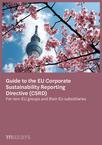Who will be impacted?
There are three ways in which non-EU groups or companies will be affected by the CSRD: if they have securities listed in the EU, have significant activity in the EU, or are parent companies of in-scope EU subsidiaries. Indeed, the CSRD will first and foremost apply to all EU-based companies that meet the directive’s scoping requirements, regardless of where the parent company is domiciled. These companies may, however, benefit from the CSRD exemption principle in specific cases and under certain conditions.
What is the timing?
For non-EU companies or groups whose securities are admitted to trading on an EU-regulated market, application of the CSRD will occur progressively, starting from the 2024 financial year for those with (i) more than 500 employees and (ii) with more than €20m balance sheet total or more than €40m net turnover, with a report published in 2025.
Non-EU groups with significant activity in the EU will also be required to provide sustainability information from the 2028 financial year, with a report published in 2029 but within a less burdensome regulatory framework.
For in-scope EU subsidiaries, application of the CSRD will apply progressively depending on size and whether the subsidiary is listed or unlisted. For large listed subsidiaries with more than 500 employees, the CSRD will apply from the 2024 financial year with a report published in 2025.
What standards will apply?
Depending on the situation, the related sustainability report will have to be prepared using either the general European Sustainability Reporting Standards (ESRS), or equivalent standards as determined by the European Commission. Non-EU groups having significant activity in the EU will be able to apply specific ESRS yet to be developed. In addition, the report will be established at the consolidated level of the ultimate non-EU parent entity covering all EU and non-EU subsidiaries and will be accompanied by a mandatory assurance opinion.
What is the impact at Member State level?
As each Member State will have to adopt measures to incorporate the CSRD into its national law, these measures should be closely monitored to determine any potential differences in the application of the CSRD.
This website uses cookies.
Some of these cookies are necessary, while others help us analyse our traffic, serve advertising and deliver customised experiences for you.
For more information on the cookies we use, please refer to our Privacy Policy.
-
This website cannot function properly without these cookies.
-
Analytical cookies help us enhance our website by collecting information on its usage.
-
We use marketing cookies to increase the relevancy of our advertising campaigns.





